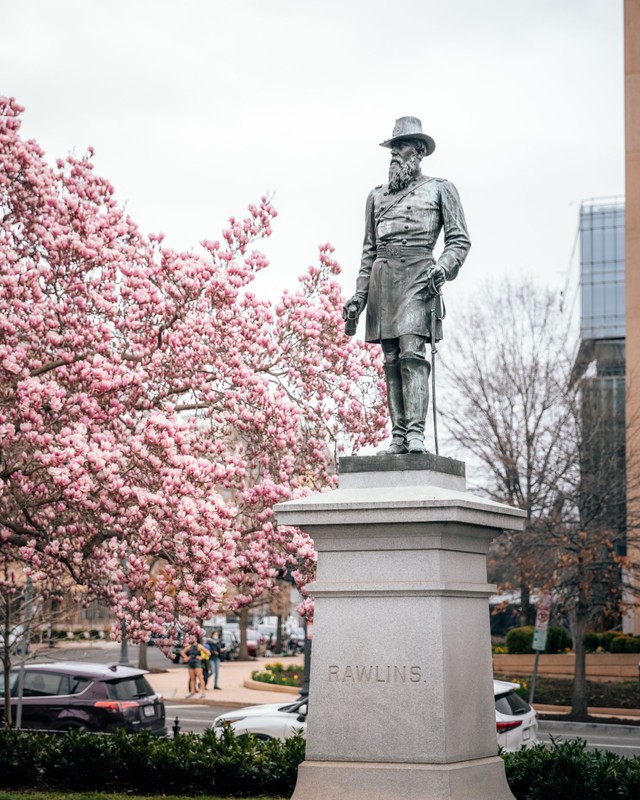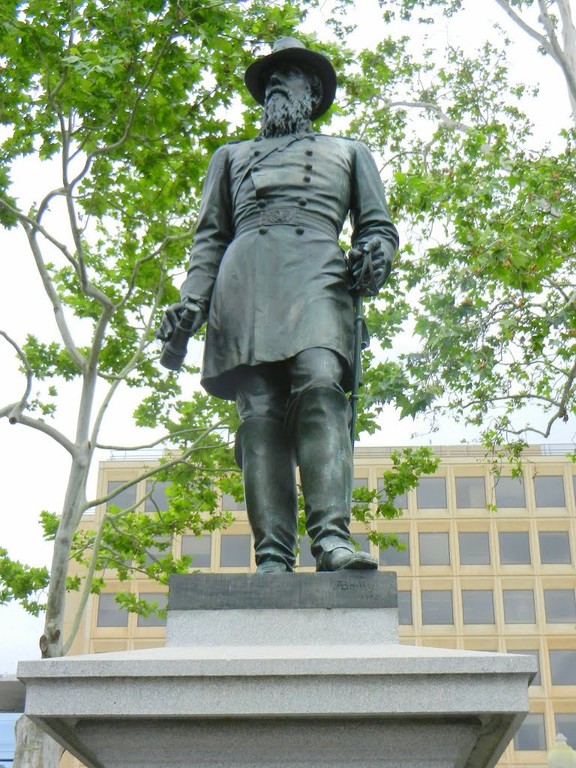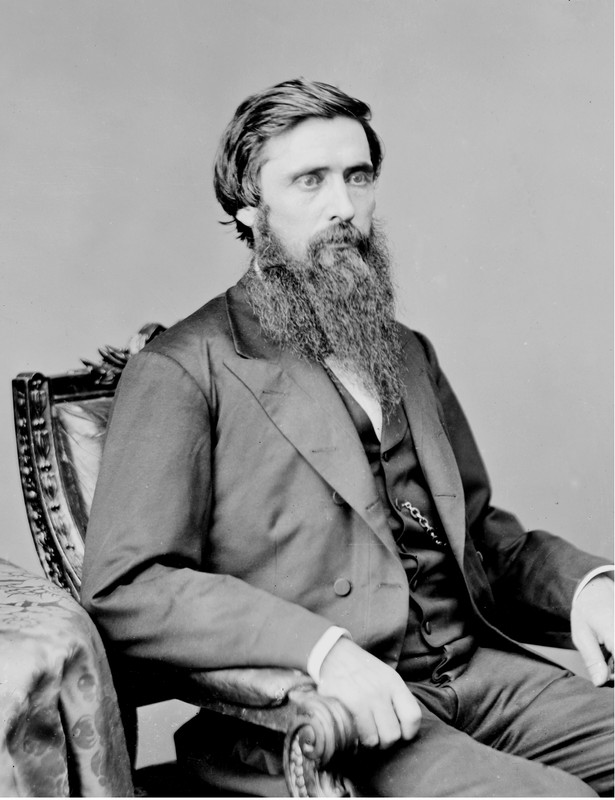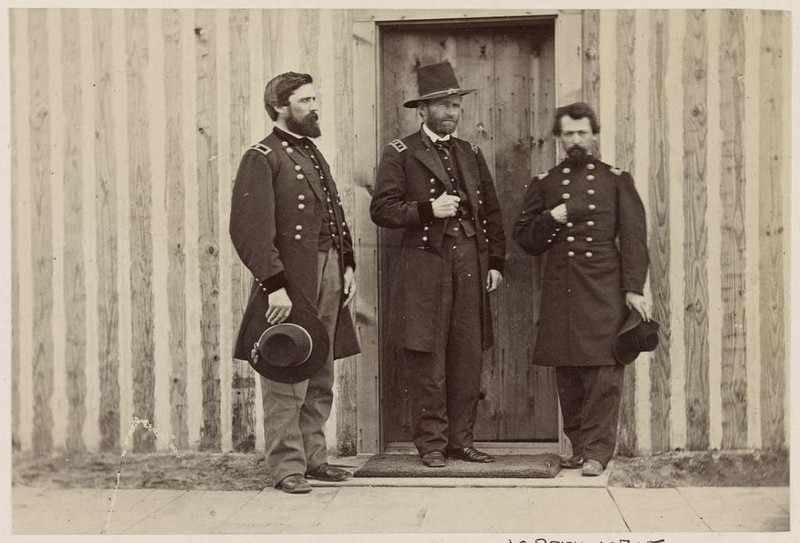Major General John A. Rawlins Memorial
Introduction
Text-to-speech Audio
Images
Major General John A. Rawlins Memorial in Washington, D.C.'s Rawlins Park

A closer look at the bronze sculpture of Rawlins by Joseph A. Bailly

John A. Rawlins (1831-1869)

A photograph of Rawlins (left) and Grant (center) during the war

Backstory and Context
Text-to-speech Audio
John Aaron Rawlins was born on February 13, 1831 in Jo Daviess County, Illinois. In 1849, he became responsible for the care of his mother and siblings when his hard-drinking, feckless father left for California in search of gold and did not return for three years. After attending Rock River Seminary in Mount Morris, Rawlins read law in Galena under Isaac P. Stevens and passed the bar in 1854. Three years later, after practicing in partnership with his mentor, he became Galena’s city attorney. While living and working there, Rawlins befriended a clerk at a leather goods store named Ulysses S. Grant.
Shortly after the outbreak of the Civil War in the spring of 1861, Rawlins helped organize the Forty-Fifth Illinois Infantry, a volunteer regiment composed mostly of men from Galena and other communities in northwestern Illinois. A few months later, he agreed to become aide-de-camp to Grant, who at the time was colonel of the Twenty-First Illinois Infantry, another volunteer regiment. Rawlins ultimately remained by Grant’s side for the remainder of the conflict, becoming his most influential advisor and witnessing some of the most important moments of the conflict, including the fall of Vicksburg and Lee’s surrender at Appomattox. Consequently, as Grant’s star rose, so too did Rawlins’s rank. By the end of the war, he was a brevet major general in the regular army.
Following the bloody, four-year conflict, Rawlins took part in the military escort that accompanied Grenville Dodge’s 1867 western expedition, which surveyed lands along the proposed route of the Union Pacific Railroad. Two years later, after Grant was elected President of the United States, he became U.S. secretary of war. Rawlins’s tenure in the position, however, proved short. Battling a relentless case of tuberculosis since the war, he died of the disease on September 6, 1869 in Washington, D.C. at the age of thirty-eight. Originally buried in Congressional Cemetery, his remains were eventually reinterred in Arlington National Cemetery.
In the immediate wake of Rawlins’s death, a movement began to erect a statue in his honor in Washington, D.C. The effort, however, eventually lost steam, compelling President Grant to write a letter to Congress pleading for action. In June 1872, Congress obliged, passing an act that appropriated $10,000 for a statue of Rawlins in the nation’s capital. Designed by French-born sculptor Joseph A. Bailly and perched atop a tall granite pedestal, the bronze sculpture depicts the general standing at ease, in full military uniform, scanning the horizon. His right hand clutches a pair of binoculars, while his left rests on the hilt of his sheathed sword. Installed in Rawlins Park in November 1874, it is believed to have been cast from Confederate cannons Rawlins captured during the war. In 1880, appalled by the park’s dilapidated condition, members of the Grand Army of the Republic petitioned to have the statue moved to a more prominent location. Over the next handful of decades, the sculpture was moved two additional times before finally being reinstalled in 1931 in its original location, where it remains today. The adjacent reflecting pool was added several years later in 1938.
Sources
"General John A. Rawlins, (sculpture)." Art Inventories Catalog. Smithsonian American Art Museum. Smithsonian Institution Research Information System (SIRIS). Web. 27 April 2021 <https://siris-artinventories.si.edu/ipac20/ipac.jsp?&profile=all&source=~!siartinventories&uri=full=3100001~!19546~!0#focus>.
Jacob, Kathryn Allamong. Testament to Union: Civil War Monuments in Washington, D.C. Baltimore: The Johns Hopkins University Press, 1998.
"John Aaron Rawlins." galenahistory.org. Galena & U.S. Grant Museum. Web. 27 April 2021 <https://www.galenahistory.org/research/nine-generals/john-aaron-rawlins/>.
"Major General John A. Rawlins Memorial." NPS.gov. U.S. Department of the Interior. 29 October 2020. Web. 27 April 2021 <https://www.nps.gov/places/000/major-general-john-a-rawlins-memorial.htm>.
Wright, John D. The Routledge Encyclopedia of Civil War Era Biographies. New York: Routledge, 2013.
https://ihitthebutton.com/rawlins-park-dc/
https://mapio.net/pic/p-91278465/
https://en.wikipedia.org/wiki/John_Aaron_Rawlins
https://picryl.com/media/gen-john-a-rawlins-left-gen-us-grant-center-and-an-unidentified-officer
